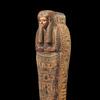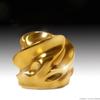ONE OF THE OLDEST ARTWORKS EVER OFFERED AT CHRISTIE’S ANTIQUITIES SALE: A 9,000-YEAR-OLD NEOLITHIC MASK FROM THE JUDEAN DESERT
- NEW YORK, New York
- /
- May 29, 2012
On June 8, Christie’s Antiquities sale will offer a 9,000-year-old limestone mask from the Judean desert that is among the earliest sculptural types to survive from the ancient Near East. Additional highlights among the 260 lots in the sale are an extremely rare Egyptian painted votive linen from the 18th-19th Dynasty (circa 1300 – 1200 B.C.), beautiful examples of 2nd century A.D. Roman sculpture—a head of Apollo and a torso of Venus—and one of only four known complete standing figures in marble of a Roman actor wearing the theater mask of the “Old Man of Comedy.” The sale also offers a wide and varied selection of antiquities from distinguished private collections including Property from the Arthur M. Sackler Collections, Property from the Estate of Ernst Beyeler, and Property from the Collection of Alan Dershowitz and Carolyn Cohen. The sale is estimated to achieve in excess of $8 million.
The intriguing design of the Neolithic limestone mask (estimate: $400,000-600,000) evokes a skull, although the function of the object remains a mystery. Too heavy to wear, the mask is human-sized, with holes for the eye sockets, a small nose portraying only the nasal bones, and an open, lipless mouth with teeth. Given the skeletal representation, experts believe that masks like this one were related to death rituals or ancestor worship among the cultures of ancient Judea in the Neolithic period, circa 7th millennium B.C. Small drill holes along the perimeter suggest that hair might have been affixed, or they might have been used to secure the mask over the face of a deceased person or perhaps to a wall, pillar or statue.
In contrast to the mysterious mask, the Egyptian painted linen votive textile (estimate: $80,000-120,000) has ten columns of crisp, black hieroglyphics explaining in great detail the image below, rendered in still-vibrant hues of russet, blue, green and gold on a white background. Recovered in 1906 from a shrine in the hills of Western Thebes, the panel depicts a scene of the goddess Hathor in the form of a cow with an earlier Pharaoh, Neb-hepet-Re Mentu-hotep, both being venerated by a priest and his family. The work dates from the New Kingdom, 18th-19th Dynasty (circa 1300-1200 B.C.), and of the surviving textiles from that shrine, the present one is perhaps the finest, both in terms of the quality of the painting and its state of preservation. It has been in the collection of the Heckscher Museum in Huntington, N.Y., since the 1950s, and has been widely published and exhibited. It is being sold to benefit the museum’s art acquisition fund.
Among the many classical artifacts in this sale is a remarkably intact standing figure of a Roman marble actor (estimate: $150,000-250,000) wearing the mask of the Old Man of Comedy, created circa late 1st century-early 2nd century A.D. The character was still popular in the comedic theater of the day, though based on the “New Comedy” of the Greek playwright Menander and his contemporaries in the 4th century B.C. A number of masks survive depicting the Old Man of Comedy with his stylized beard and hair, exaggerated expression and openings for the eyes and mouth, but only three other complete standing marble figures are known to survive.
Two other Roman works of art include a marble head of Apollo and a slightly larger than life-size marble torso of Venus (both estimated at $300,000-500,000). Finely sculpted, this voluptuous Venus torso closely resembles the pose of the famous Venus de Medici, a Roman interpretation of the goddess now in the Uffizi Gallery. The head of Apollo is rendered in an eclectic classicistic style based on the 5th century B.C. In addition to these two gods, the sale includes several marble portrait heads, including one of Emperor Antoninus Pius (estimate: $150,000-250,000), which is briefly reunited with his daughter Annia Galeria Faustina (estimate: $100,000-150,000) at Christie’s.

270x400_c.jpg)

10270x400_c.jpg)
__A270x400_c.jpg)
270x400_c.jpg)


_Infinity_by_Santiago_Medina_PhotoCr100x100_c.jpg)












